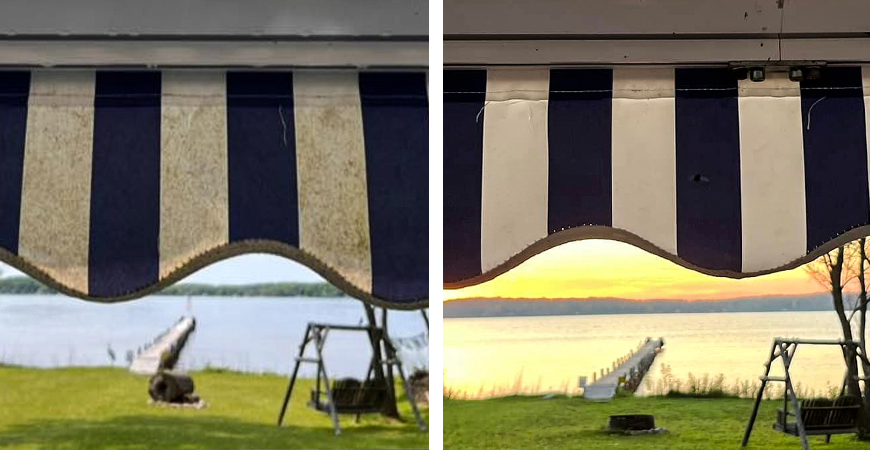
Outdoor fabric awnings add shade, beauty, and personality to your home or business — but they also collect dirt, mildew, bird droppings, and pollen over time. 😣 If you’re considering using a pressure washer to clean them, you’re probably wondering:
What type of nozzle is safest and most effective for cleaning fabric awnings?
Spoiler alert: not all nozzles are created equal — especially when it comes to delicate materials like canvas, polyester, or acrylic awnings.
Let’s dive into everything you need to know to safely clean your outdoor awnings without causing rips, frays, or discoloration. 💧🎯
🛑 The Risk: Why You Can’t Use Just Any Nozzle
Awnings aren’t built like driveways or siding. They’re:
- Flexible and often lightweight
- Held in place by grommets, fasteners, or tension bars
- Prone to tearing with direct high-pressure contact
Using the wrong nozzle or too much pressure can cause:
- Permanent rips or holes
- Frayed edges
- Water intrusion that leads to mold growth
- Faded or discolored fabric
That’s why nozzle selection (and pressure settings) matter so much here. 🧠
✅ Best Nozzle Type for Fabric Awnings: The 40° Nozzle
The 40-degree white nozzle is typically your safest and most effective option for cleaning outdoor awnings. Here’s why:
- It produces a wide, gentle spray
- Reduces pressure impact by dispersing water over a larger area
- Minimizes the risk of fraying or puncturing the material
- Allows you to rinse and clean without direct force
💡 Bonus Tip: If your pressure washer has adjustable PSI settings, dial it down to 800–1200 PSI max when using this nozzle on fabric.
🟡 Optional: 25° Green Nozzle for Heavier Soiling
If your awning has heavy mildew or grime buildup, you can consider a 25-degree green nozzle, but only with extra distance (at least 24–36 inches from the surface).
Use this only if:
- The awning is made of tougher synthetic material (like vinyl or acrylic)
- You’re spraying at an angle, not head-on
- You’re confident it can handle the added force
Still, the 40° nozzle is usually the smarter starting point.
Browse Amazon Here For Popular Pressure Washers And Accessories
🔫 Avoid These Nozzles for Awnings
- ❌ 0° Red Nozzle (Pencil Jet): Too focused, will tear fabric instantly
- ❌ 15° Yellow Nozzle: Better suited for hard surfaces, too aggressive
- ❌ Turbo/Rotary Nozzles: Can destroy stitching or bindings on contact
These should never be used on awnings, even from a distance.
🧴 Should I Use Soap or Just Water?
Water alone won’t always do the trick — especially for mildew or sap stains.
For best results:
- Use a mild detergent or awning-specific cleaner
- Make sure the product is non-bleaching and fabric-safe
- Apply the soap using a soap nozzle or low-pressure tip
- Let it dwell for 3–5 minutes, then rinse thoroughly with your 40° nozzle
Avoid using bleach or harsh chemicals, especially on canvas, as they can damage fibers and cause fading.
Browse Amazon Here For Popular Outdoor Fabric Cleaners
✅ Steps to Pressure Wash Fabric Awnings Safely
- Brush Off Loose Debris 🧹
Use a soft broom or dry cloth to remove leaves, dirt, and cobwebs. - Test a Small Area First 🧪
Always test your pressure settings and nozzle on a corner before full application. - Spray at an Angle ↘️
Never spray perpendicular to the fabric. Angled spraying reduces force and prevents lifting seams. - Use Gentle, Overlapping Motions 🔁
Work from top to bottom in smooth passes, rinsing as you go. - Avoid Soaking the Awning Frame 🏗️
Prolonged exposure to water can rust or weaken metal supports over time.
🌦️ Can I Leave the Awning Wet to Dry?
Yes — but ideally on a sunny day. ☀️
To prevent mildew, always allow the awning to dry completely before retracting or folding it. If possible, tilt it slightly so water runs off rather than pooling.
🏁 Final Thoughts
Pressure washing your fabric awning is completely doable — but only if done the right way. Stick with a 40° nozzle, keep the PSI low, and use soft, deliberate passes. It’ll leave your awning refreshed and vibrant — without the damage. 😎🧽🌈
Browse Amazon Here For Top Rated Power Washers And Accessories






